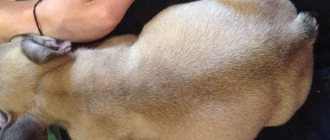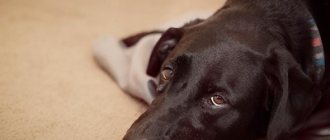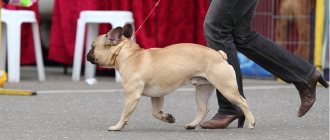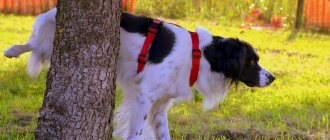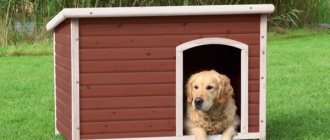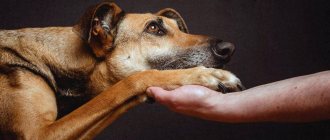From 0 to 2 weeks - neonatal period
This stage lasts about two weeks after birth, and the puppies remain blind and deaf during this time. They have no teeth and cannot control their own body temperature
The puppies will sleep almost constantly, but their mother will take care of all their needs: keeping them warm and clean, as well as feeding them.
Photos of 2-day-old Labrador puppies:
Photos of Labrador puppies 1 week:
From 2 to 4 weeks - transitional stage
Puppies will begin to open their eyes and respond to nearby lights, sounds and movement. During this period, they will also begin to go to the toilet on their own and begin teething.
You will also notice that the puppies begin to move more and more. And although at first they will mostly crawl, they will soon begin to walk and even run. The puppy will also begin to recognize its siblings and mother during this time. At some point he may even try his mother's regular food, but he will still need his mother's milk
Photos of Labrador puppies 2 weeks:
Photos of Labrador puppies 3 weeks:
From 3 to 4 weeks - development of feelings
At this time, the puppy will quickly develop all its senses. He will begin to recognize his environment, as well as people and all objects around him. At this stage, you must especially carefully protect the puppy's safety: from loud noises and other sudden situations that can greatly affect the development and character of the future dog.
It is extremely important that the puppy stays with its mother at this time and learns “how to be a dog” and how to interact with its own kind. Starting at 3 weeks of age, puppies learn:
- Basic behavioral patterns of dogs;
- The meaning of bites, and what it's like to be bitten;
- The meaning of various postures and their effect on other animals;
- The meaning of barking and other sounds;
- How to establish and develop relationships with other dogs.
Photos of Labrador puppies 4 weeks (1 month):
approximate cost
How much does a Labrador puppy cost? The cost of these babies can be very different: they are sold at both quite reasonable and exorbitant prices. You can buy a baby without vaccinations, certificates and a veterinary passport for 5–15 thousand rubles. If the puppy has a passport, you can purchase it for 20–35 thousand rubles. Although with such dogs you are unlikely to win at the show.
If you purchase a Labrador for the purpose of participating in exhibitions, purchasing such a dog will cost you 40–60 thousand rubles. Such a dog, as a rule, has excellent characteristics and all the necessary documents.
Related article: How to care for a puppy and an adult Labrador
From 4 to 8 weeks (1-2 months) - socialization stage
Once the puppy reaches 4 weeks of age, he will begin to learn the most important things in his life related to social behavior. He will learn not to bite and interact with other dogs and animals.
Social interaction with people is especially important between the 5th and 8th weeks. During this time, the puppies will also learn discipline from their mother. She will begin to wean her puppies and teach them proper manners.
You can begin to gradually introduce regular food into your puppy's diet from about 4 weeks of age. Start with small amounts as the mother is still feeding them.
Make sure to exercise your puppy regularly every day. But do not separate him from his fellow dogs for more than 10 minutes, as this may lead to problems with socialization.
Dogs that have been separated from their mother and litter too early may be more nervous and bark and bite more often. Problems with further training and socialization can also often be attributed to puppies that are separated from their siblings too early.
Photos of Labrador puppies 1.5 months old:
Photos of Labrador puppies 2 months:
How to choose a Labrador Retriever puppy
The decision to get a dog should be supported by all family members. This is a very responsible step, because worries will most likely have to be shared by everyone. The Labrador is perfect as a family pet. But before you make a choice, you need to learn more about the breed. To do this, it is not enough to look through articles on the Internet; you need to chat on dog breeders forums and ask questions to breeders. But the most important thing is that you need to get to know the breed in person. To do this, go to an exhibition or arrange a meeting with the Labrador owner. Then you will understand how this breed makes you feel and whether you need a dog at all.
If you haven't changed your mind, determine what you need the dog for. Will he be a pet or a show champion? The cost of the puppy depends on this. But don't skimp. Unfortunately, under the guise of a popular breed, they often sell mestizos who do not even have Labradors in their family. Even if you just want a dog for your soul, find a kennel that has inexpensive dogs that have not passed the conformation requirements. The breeder guarantees that the pet is healthy and that it is truly a Labrador Retriever.
If you have already moved on to choosing a puppy, you need to re-read the breed standard again and evaluate the appearance of your future ward. Find out who his parents are, if possible, get to know them. Then you need to observe the cubs in natural conditions. Choose the most playful and active one. Pay attention to the condition of the coat (it should be shiny), cleanliness of the eyes and ears. Be sure to ask the mother’s owner what vaccinations the puppies have received, how to feed them, and what will be needed to place the pet in a new home.
From 2 to 3 months - the second stage of socialization
During this period, puppies continue to hone their social skills and also go through a "fear" phase, where they are afraid and frightened by almost everything, including objects with which they were already familiar.
To soften this stage for puppies, avoid any traumatic situations, punishment, or loud noises. Make sure you and your pet have regular contact. During this time, you can also begin leash training and teaching basic, simple commands.
During this period, you should not take your puppy to areas where there are street or stray dogs as they may have diseases that can be fatal to your puppy. Long walks should wait until your pet has completed the full course of vaccinations.
Photos of Labrador puppies 3 months:
What to look for when purchasing
In order not to make a mistake in your choice, you need to know exactly what a healthy Labrador puppy looks like. Although there is an opinion that when buying a puppy it is impossible to predict how it will grow up, it is worth doing everything to ensure that your choice is successful. Therefore, now we will characterize the puppies that are most likely to grow up to be real handsome dogs.
We recommend this article:
Can a Labrador live in an outdoor enclosure in winter?
External indicators
To identify a healthy puppy with excellent performance, pay attention to the following indicators:
- Hairline. The outer layer of wool, according to the standard, is very coarse and hard, but the undercoat is smooth and silky. In addition, the undercoat should be thick. All other cases (sparse undercoat, too long coat) are not included in the standard and are considered unsuitable for dogs of this breed.
- Dog's tail. It should resemble an otter's tail, which allows the animal to swim well. It should be short and thick at the base (as thick as a human arm), and slightly tapered at the bottom. When moving, it should be lowered, without rising above the level of the back. As a rule, such a tail is formed in individuals with a short back, so pay attention to this. If the tail is too long or too thin, you are unlikely to win a prize at a dog show.
- Muzzle expression. Everything is simple here - the Labrador should look as friendly as possible. No heavy or cloudy look.
- Body structure. The baby should have a deep chest and a fairly long neck, and the head should be quite large.
Related article: What is the difference between a Golden Retriever and a Labrador and which is better?
Labrador behavior
The Labrador's character is very important, since the pet must become a full member of the family. To determine whether a puppy is worth buying, take a closer look at its behavior - it should be active and friendly. If you pick up your baby, he should not be afraid or behave aggressively. As a rule, you should notice that the dog enjoys human contact. You can gently clap your hands above his head and look at the dog’s reaction - if the baby is very scared, you should not take such a puppy.
Other subtleties
When choosing a puppy, make sure that he is absolutely healthy. Carefully examine his paws, make sure that there are no dislocations or improperly fused bones. Also carefully examine the ears and eyes - they should be clean, without any signs of disease. Sour eyes or dirty ears are clear evidence that the baby is being neglected.
It is very important that he is kept clean and fed enough. Look where the puppy is kept - the place should be clean and comfortable. You can also check what kind of food he is given - there should be enough of it, and the quality should be high.
From 2 to 4 months - “teenage” period
At this stage, your puppy can be compared to a teenager. He will become more independent and may even begin to ignore your commands. If this happens, be firm and consistent, but also gentle enough, and reinforce commands and other training.
You will likely notice that your puppy will begin to test your authority by lightly biting you or playing similar games. You should stop this behavior by firmly saying “no” and ignoring your puppy for a few minutes.
Continue to play with your puppy regularly, but don't fight him. Otherwise, you can teach him that fighting you is good, and then sooner or later he will challenge your authority.
Photos of Labrador puppies 4 months:
Health and illness
Labrador Retrievers have a predisposition to certain diseases. It has already been said that these dogs are prone to gluttony. If the owner indulges the pet's weakness, sooner or later he will gain excess weight. And as a result of obesity, other problems can appear.
In order not to prevent obesity in a dog, it is necessary to constantly monitor its weight and change its diet if extra pounds appear. You can check the presence of unnecessary fat yourself using palpation. In Labrador Retrievers with normal body condition, the ribs can be easily felt when pressing on the sides. However, you cannot see them. Therefore, it is impossible to determine obesity by eye.
Labradors can suffer from diabetes, but much more often from pathologies of the musculoskeletal system. The most serious and common is hip dysplasia; by the way, there is a genetic predisposition to it. This disease often leads to disability.
Dogs of this breed have eye problems: cataracts, retinal atrophy. They usually develop with age, after 4-5 years. Like many intelligent breeds, Labradors are prone to epilepsy. This is a serious disease, but with the right choice of medication, the animal can live a full life.
A predisposition to certain pathologies does not mean that Labradors are frail and unhealthy. Most representatives of this breed live quite a long time for large dogs, on average 13-14 years.
From 3 to 6 months - social dominance
During this period, the puppy is more likely to start trying to show dominance over children and other members of your family. He will watch you and other people very carefully, selecting appropriate human reactions.
The puppy will begin to learn the hierarchy in his pack (family) and will try to figure out where he is in this hierarchy.
Starting at 3 months, the puppy will begin to:
- question authority
- try to dominate animals and people
- grab the leash
- growl periodically
Counteract this by continuing obedience and basic command training. If the puppy becomes agitated or aggressive, simply stop any activity with him. Your dog's molars will also begin to come out during this time, so give him plenty of toys that he can chew safely.
Photos of Labrador puppies 5 months:
Photos of Labrador puppies 6 months:
From 6 to 18 months - young dog
Starting at 6 months, your puppy is already in the final stages of his development, but he is still very young. At this time, the puppy will be full of energy and will continue to explore the world around him.
It's important to remember that your buddy is still a puppy, even though he looks like an adult dog. You can start working on advanced levels of training, or continue training him to interact in a non-aggressive manner with other animals and people.
It is also likely that your dog will go through another "fear" stage after reaching 6 months. Not all Labradors experience this stage again, but if it does, you know what to do.
Photo of Labrador 1 year:
Diet of a small Labrador
A dog, if it is fed correctly, always has the same weight, looks healthy, its coat is shiny and free of dandruff. A good appetite is an indicator that the dog is being fed properly. At a young age, it is better for the pet to be rather thin in appearance than fat, so as not to interfere with the development of tendons and joints. It is better to stick to the diet that the breeder practiced, and only introduce new products over time.
Approximate daily diet for a small Labrador: meat 15 g per 1 kg of dog weight, carbohydrates - 5 g per 1 kg of weight, fats - 2 g per 2 kg of weight. Don't forget to drink - clean water should always be available. Stick to the formula above and avoid:
- fatty pork;
- sausages;
- peppery and spicy foods;
- bones (can lead to constipation);
- spoiled products;
- any sweets.
How many times should you feed your puppy?
Until two months of age, Labrador puppies eat 6 times a day. Do not feed the puppy at night; distribute these 6 feedings throughout the day approximately every 3.5-4 hours, and then, as the number of feedings decreases, increase the interval between them. From 2 to 4 months the puppy is fed 5 times a day, from 4 to 5 months - 4 times, from 5 to 6 months - 3-4 times. From 6 months, gradually transfer your Labrador puppy to the diet of an adult Labrador. From the age of 6 months, feed your Labrador twice – in the morning and in the evening, at certain hours.
What to feed with a natural diet
If you feed your Labrador with regular food, it is important to properly balance the diet. Remember: Labrador puppies are not gourmets, there is no need to try to diversify their food - it is better for the food to be the same, but always complete. Any flavoring additives (spices, ketchups, mayonnaise, etc.) are harmful and dangerous for a dog. Include in your diet:
- Meat is a large part of natural nutrition. Any part of beef is included in the diet (goulash is suitable, take tendons, veins, trachea, cheeks), lamb is recommended. Give the meat raw, fresh or after freezing. You cannot cook it for a long time if it is intended for a dog.
- Vegetables and fruits, herbs (vegetable components are given lightly stewed in a frying pan, boiled in water).
- Porridge. Keep in mind that many people love buckwheat and are allergic to it.
- Rejuvenating face mask with yeast
- How to water strawberries
- Ultrasonic Bird Repeller
Premium ready-made food
When feeding your Labrador with ready-made food, there will be no problems with choosing a diet. The question is one thing - the food needs to be selected successfully. Buying the most expensive one will not guarantee that it will suit your dog. Buy food in small packages at first. Study how your Labrador reacts to it, whether there are any allergic reactions: check for redness in the ears, belly, and interdigital spaces. See if your Labrador eats this food with pleasure. Pay attention to dry food from the Holistic line.
Latest tips
Now that you know what stage of development your puppy is at, you can better meet his needs. Provide him with plenty of social contact with his siblings, as well as people and other types of pets.
Your dog should reach physical and emotional maturity between 1 and 2 years of age, depending on the type of Labrador you have. Since there are many types and varieties of Labradors, they are considered fully mature between 2 and 2.5 years of age.

